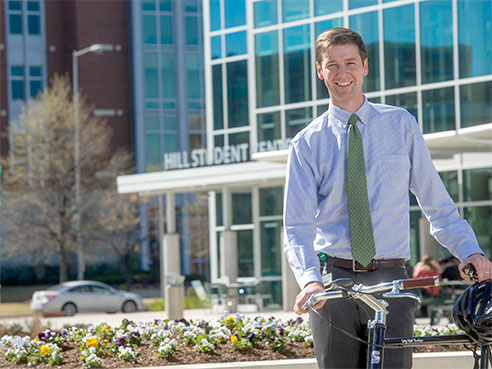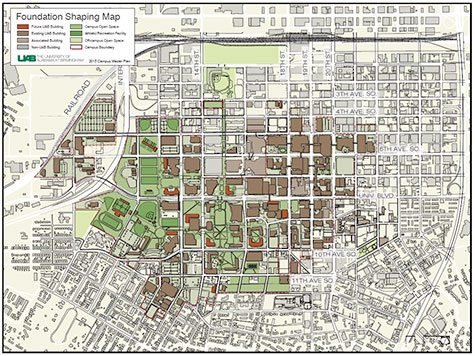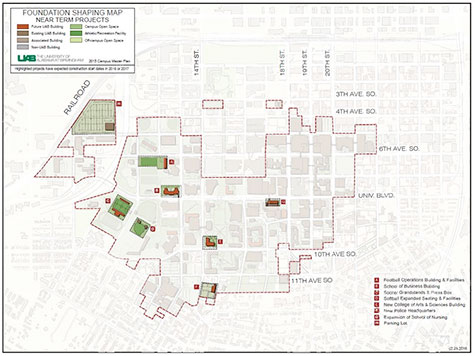 James Fowler, Director of Planning Design and Construction
James Fowler, Director of Planning Design and Construction
One year ago, the University of Alabama at Birmingham began an ambitious goal to update the university’s master plan to help strategically guide the physical shape of the campus — the first such comprehensive update since the university’s last adopted master plan was prepared and approved in 2001.
Representatives from the UAB Facilities Division engaged staff, faculty, community stakeholders and City of Birmingham representatives throughout the summer and fall of 2015 to get a broad cross section of the campus community to help guide the physical development of the campus in a manner that supports the five pillars of the University’s Strategic Plan. These pillars are education, research, patient care, community and global service, and economic development.
The result is a new, comprehensive Campus Master Plan that will enable the university to refocus its efforts to capture an overall vision for campus development in the next five years and serve as a foundation beyond.
“In so many ways, our physical campus supports our very important and very aggressive vision, which is to be an internationally renowned research university and a first choice for education and health care,” said UAB President Ray Watts, M.D. “Our continued efforts to create a campus that is both beautiful and sustainable will help us achieve our multifaceted mission. This Campus Master Plan is about continuing to grow and change our home — our community of Birmingham — for the better. In that great effort, we will continue to build a foundation for changing our world.”
Key components of the plan, adopted by the University of Alabama System Board of Trustees in February, include travel into and within the campus by creating areas that are walkable, safe for cyclists, transit-friendly and easily accessible for visitors; being well-integrated with the business community around UAB to enable the university to be a top-level, aggressive driver of innovation; and being great partners with all of the university’s many neighbors within our central urban setting.
“New development and improvement of infrastructure and services will create a more attractive, convenient and sustainable residential campus,” said Allen Bolton, UAB vice president of Finance and Administration. “The campus envisioned in this plan will have a strong, unified sense of place and will offer an enriching environment for living, working, playing and studying at UAB. Students, faculty, staff and visitors will be able to get around the campus easily and safely as a result of the planned ongoing improvements. Through this planning and design of our future investments in our campus, we want to encourage investment by others that support the well-being of the university and our neighbors, downtown Birmingham and the city overall.”
 Click to enlarge. This map shows where future UAB buildings are planned, along with the campus boundary. Increase density, safety and alternative transportation
Click to enlarge. This map shows where future UAB buildings are planned, along with the campus boundary. Increase density, safety and alternative transportation
James Fowler came to the UAB Facilities department in the spring of 2015 from Atlanta, where he worked in the private sector on transportation and community planning for eight years.
Fowler, a licensed civil engineer and Shelby County native, worked with colleagues in Planning, Design and Construction to create the new Campus Master Plan. Current UAB land holdings make up approximately a quarter of the downtown central business district in Birmingham — over 100 city blocks — and with thousands of faculty, students, employees and visitors on campus each day, Fowler says the way these pieces move throughout the footprint is critical.
To do this safely and efficiently, Fowler says focusing on the density of the campus is important. But reshaping the campus density elements will go beyond new buildings and additions, like the new planned homes for the College of Arts and Sciences, the Collat School of Business, the upward expansion of the School of Nursing, and athletic improvements on the western side of campus.
“Focusing on density is important, and that’s absolutely a part of what we’re doing,” Fowler said. “That’s going to make our campus more accessible by alternative modes of transportation. We need to continue our transition away from being such an auto-oriented campus to one that’s also pedestrian-, transit- and bicycle-friendly.”
To do this, the Campus Master Plan focuses on the character of the streets within the university. Fowler aims to move campus roadways toward being “complete streets,” meaning roadways that accommodate all modes of transportation.
“Streets can be great spaces,” he said. “When they have a large tree canopy, safe pedestrian crossing, bike lanes and nice sidewalks, streets can almost act like linear parks and tie the campus together.”
Proposals are already in hand for how to shrink campus intersections and make them feel more crossable — and safe — for pedestrians. As part of this effort, UAB is studying a network of streets in partnership with the City of Birmingham and the Regional Planning Commission where roadway space can be re-allocated for shorter pedestrian crossings, bike lanes and landscaped medians.
“We really want our intersections to send the message to drivers that they are driving in a walkable, multimodal environment,” Fowler said. “We want everyone on campus to feel safe when they are walking or riding their bikes.”
Integrating with the city
The need to continue and further enhance UAB’s integration within the city to promote innovation, partnerships and connectivity to the community also is a focus of the plan.
Fowler says stakeholder involvement with neighborhoods, adjacent institutions and businesses, and the city is essential to making this happen.
 Click to enlarge. This map highlights some of the building and green spaces that have projected construction dates in 2016 or 2017.“We made sure to include places like Children’s Hospital and others in our conversations so we can be intentional about transitioning well at our edges, and particularly at the neighborhoods,” Fowler said. “We want to create an enhanced connection from 15th Street to Parkside, for example. We also have a proposed green space along the south edge of campus that would act as a transitional area between our campus and the residential neighborhoods.”
Click to enlarge. This map highlights some of the building and green spaces that have projected construction dates in 2016 or 2017.“We made sure to include places like Children’s Hospital and others in our conversations so we can be intentional about transitioning well at our edges, and particularly at the neighborhoods,” Fowler said. “We want to create an enhanced connection from 15th Street to Parkside, for example. We also have a proposed green space along the south edge of campus that would act as a transitional area between our campus and the residential neighborhoods.”
Another aspect of the integration is to continue work with the city and the business community to foster a culture of innovation in the downtown area. “We do such a tremendous amount of research on UAB’s campus, and it’s important to make sure we’re connecting the great work we’re doing with the different partners in the community around us — in both the public and private sectors.”
What’s next?
The Campus Master Plan is a foundation document that sets some high-level objectives, and points to some specific follow-up studies that need to be performed.
Specific streetscape standards are being developed to help achieve a consistent look and feel within the UAB footprint. The development of the Athletics Master Plan also is in its final phase, and a parking and transportation study is underway.
Other “what’s next” objectives include an updated look at housing needs, continued study of academics space utilization, a Medical Facilities Master Plan and a Sustainability Master Plan, among other, continued strategic planning within each department and school. The aim is to complete these studies and begin their implementation within the next five years.
“The plan really sets a positive direction for where we’re headed as an institution,” said Greg Parsons, assistant vice president for Planning, Design and Construction. “All of the discussions about connectivity, open space and new facilities creates a very positive and bright future for UAB. And, hopefully, some of these things will begin to take shape and be noticeable in the near future.”